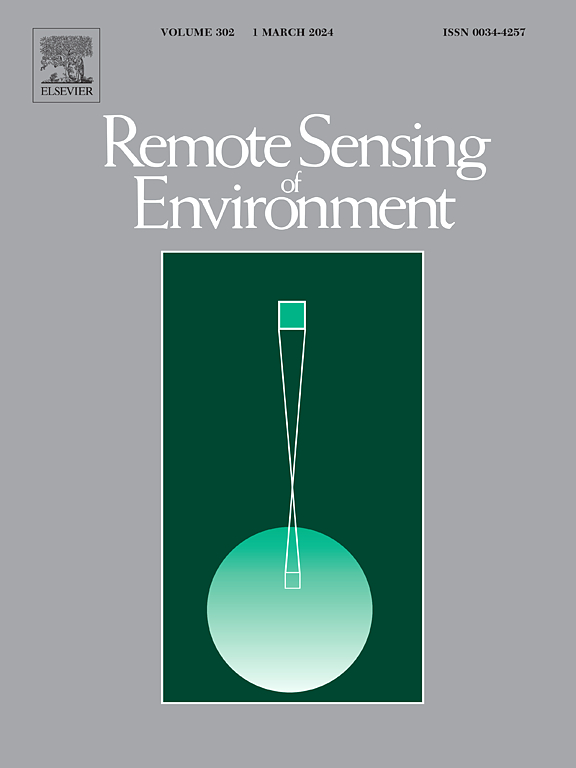A novel Multiple Persistent Peaks (MPP) retracker to improve global inland water level monitoring from satellite radar altimetry
IF 11.1
1区 地球科学
Q1 ENVIRONMENTAL SCIENCES
引用次数: 0
Abstract
Satellite altimetry has become an indispensable technique for large-scale monitoring of inland water levels, which is fundamental to understanding the hydrologic dynamics of surface water and informed water resource management in the scenario of changing climate. Yet the capacity of inland altimetry can be further improved regarding the accuracy and the spatial-temporal coverage of water level estimates. This study presents a new Multiple Persistent Peaks (MPP) retracker to improve the retrieval of inland water levels from satellite radar altimetry. Focusing on the long-term Jason-2/3 observations, we demonstrate how the MPP retracker works in the case of complex and multipeaked waveforms commonly encountered in inland radar altimetry. The MPP retracker determines surface elevations of the target water body by grouping and multi-objective analysis of multiple along-track height profiles corresponding to persistent peaks in the aligned averaged waveform. We evaluated the results globally at 41 gauge stations and 6 crossovers with various climate, terrain, and hydrologic settings. The root-mean-square-error (RMSE) of the altimetry-derived water levels with in situ measurements is between 0.19 m and 0.78 m (median value of 0.38 m) and within the range of 0.25–0.49 m at crossovers. The validations show that the new automated method outperforms classical retrackers in terms of accuracy and robustness and is applicable to both pulse-limited and SAR altimetry. Our approach successfully retrieved good quality water level time series at river reaches with highly heterogeneous landscapes where most retrackers exhibit errors of several meters. Based on the MPP retracker, we provided an efficient tool for sophisticated outliers filtering and correction in the final time series, which is desirable for expert evaluation and improving the quality of altimetry-derived water level products. The new automated retracker and the tool we provided is a critical step toward improved monitoring of inland water levels from satellite altimetry on a global and long-term scale.
一种新型的多持续峰(MPP)回调器改进了卫星雷达测高对全球内陆水位的监测
卫星测高已成为大规模内陆水位监测不可或缺的技术,是了解气候变化情景下地表水水文动态和知情水资源管理的基础。内陆测高在水位估算精度和时空覆盖方面还有待进一步提高。为了提高卫星雷达测高对内陆水位的反演精度,提出了一种新的多持续峰(MPP)回调器。以Jason-2/3的长期观测为重点,我们展示了MPP回调器在内陆雷达测高中常见的复杂和多峰波形情况下的工作原理。MPP回调器通过对对齐平均波形中持续峰值对应的多个沿迹高度剖面进行分组和多目标分析,确定目标水体的地表高度。我们在全球41个测量站和6个具有不同气候、地形和水文设置的交叉路口评估了结果。利用原位测量得到的高程水位的均方根误差(RMSE)在0.19 ~ 0.78 m之间(中位数为0.38 m),在交叉时在0.25 ~ 0.49 m之间。验证结果表明,该方法在精度和鲁棒性方面均优于传统的跟踪器,适用于脉冲限高和SAR测高。我们的方法成功地在具有高度异质景观的河流流域检索了高质量的水位时间序列,其中大多数跟踪器显示出几米的误差。基于MPP回退器,我们提供了一个有效的工具,在最终时间序列中进行复杂的异常值滤波和校正,这是专家评估和提高高海拔水位产品质量所需要的。我们提供的新的自动回调器和工具是在全球和长期范围内通过卫星测高改进内陆水位监测的关键一步。
本文章由计算机程序翻译,如有差异,请以英文原文为准。
求助全文
约1分钟内获得全文
求助全文
来源期刊

Remote Sensing of Environment
环境科学-成像科学与照相技术
CiteScore
25.10
自引率
8.90%
发文量
455
审稿时长
53 days
期刊介绍:
Remote Sensing of Environment (RSE) serves the Earth observation community by disseminating results on the theory, science, applications, and technology that contribute to advancing the field of remote sensing. With a thoroughly interdisciplinary approach, RSE encompasses terrestrial, oceanic, and atmospheric sensing.
The journal emphasizes biophysical and quantitative approaches to remote sensing at local to global scales, covering a diverse range of applications and techniques.
RSE serves as a vital platform for the exchange of knowledge and advancements in the dynamic field of remote sensing.
 求助内容:
求助内容: 应助结果提醒方式:
应助结果提醒方式:


